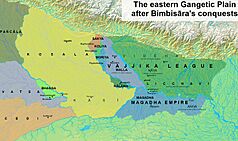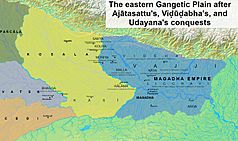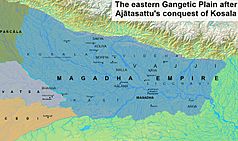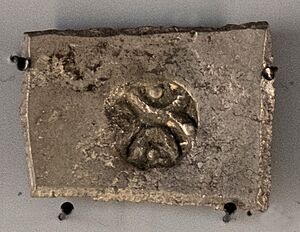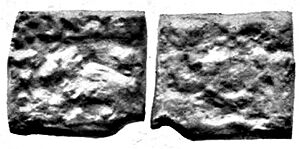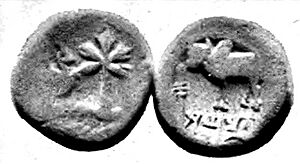Kosala facts for kids
Quick facts for kids
Kingdom of Kosala
कोसल राज्य
|
|||||||||
|---|---|---|---|---|---|---|---|---|---|
| c. 7th century BCE–c. 5th century BCE | |||||||||
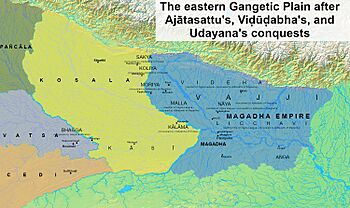
Kosala and its neighboring kingdoms.
|
|||||||||
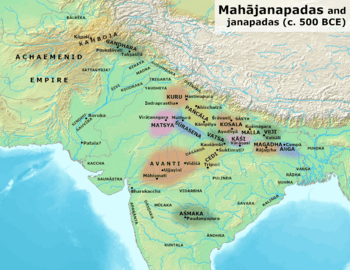
Kosala and the other Mahajanapadas in the Post Vedic period.
|
|||||||||
| Capital | Ayodhya and Shravasti of Uttar Kosala | ||||||||
| Common languages | Sanskrit | ||||||||
| Religion | Historical Vedic religion Jainism Buddhism |
||||||||
| Government | Monarchy | ||||||||
| King | |||||||||
|
• ?
|
Ikshvaku (first) | ||||||||
|
• c. 5th century BCE
|
Sumitra (last) | ||||||||
| Historical era | Iron Age | ||||||||
|
• Established
|
c. 7th century BCE | ||||||||
|
• Disestablished
|
c. 5th century BCE | ||||||||
|
|||||||||
| Today part of | India Nepal |
||||||||
Kosala, sometimes referred to as Uttara Kosala (lit. Northern Kosala) was one of the Mahajanapadas of ancient India. It emerged as a small state during the Late Vedic period and became (along with Magadha) one of the earliest states to transition from a lineage-based society to a monarchy. By the 6th century BCE, it had consolidated into one of the four great powers of ancient northern India, along with Magadha, Vatsa, and Avanti.
Kosala belonged to the Northern Black Polished Ware culture (c. 700–300 BCE) and was culturally distinct from the Painted Grey Ware culture of the neighboring Kuru-Panchala region, following independent development toward urbanisation and the use of iron. The presence of the lineage of Ikshvaku—described as a raja in the Ṛgveda and an ancient hero in the Atharvaveda—to which Rama, Mahavira, and the Buddha are all thought to have belonged—characterized the Kosalan realm.
One of India's two great epics, Ramayana is set in the "Kosala-Videha" realm in which the Kosalan prince Rama marries the Videhan princess Sita.
After a series of wars with neighbouring kingdoms, it was finally defeated and absorbed into the Magadha kingdom in the 5th century BCE. After the collapse of the Maurya Empire and before the expansion of the Kushan Empire, Kosala was ruled by the Deva dynasty, the Datta dynasty, and the Mitra dynasty.
Contents
Location
Geography
Kosala was bounded by the Gomti River in the west, Sarpika River in the south, Sadanira in the east which separated it from Videha, and the Nepal Hills in the north. It encompassed the territories of the Shakyans, Mallakas, Koliyas, Kālāmas and Moriyas at its peak. It roughly corresponds to modern-day Awadh region in India.
Cities and towns
The Kosala region had three major cities, Ayodhya, Saketa and Shravasti, and a number of minor towns as Setavya, Ukattha, Dandakappa, Nalakapana and Pankadha. According to the Puranas and the Ramayana epic, Ayodhya was the capital of Kosala during the reign of Ikshvaku and his descendants. Shravasti is recorded as the capital of Kosala during the Mahajanapada period (6th–5th centuries BCE), but post-Maurya (2nd–1st centuries BCE) kings issued their coins from Ayodhya.
Culture
Kosala belonged to the Northern Black Polished Ware culture (c. 700–300 BCE), which was preceded by the Black and red ware culture (c. 1450–1200 BCE until c. 700–500 BCE). The Central Gangetic Plain was the earliest area for rice cultivation in South Asia, and entered the Iron Age around 700 BCE. According to Geoffrey Samuel, following Tim Hopkins, the Central Gangetic Plain was culturally distinct from the Painted Grey Ware culture of the Vedic Aryans of Kuru-Pancala west of it, and saw an independent development toward urbanisation and the use of iron.
Religion
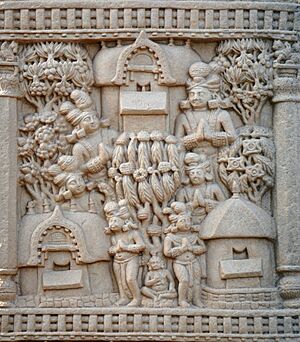
Kosala was situated at the crossroads of Vedic heartland of Kuru-Panchala and Greater Magadhan culture. According to Alexander Wynne, Kosala-Videha culture was at the center of unorthodox Vedic traditions, ascetic and speculative traditions, possibly reaching back to the late Ṛgveda. Kosala-Videha culture is thought to be the home of the Śukla school of the Yajurveda.
According to Michael Witzel and Joel Brenton, the Kāṇva school of Vedic traditions (and in turn the first Upanishad i.e, Bṛhadāraṇyaka Upaniṣad) was based in Kosala during the middle and late Vedic periods. Kosala had a significant presence of the muni tradition, which included Buddhists, Jains, Ajivikas, Naga, Yakṣa, and tree worshipers as well as Vedic munis. The muni tradition emphasized on "practicing yoga, meditation, renunciation and wandering mendicancy" as contrasted to the ṛṣis who "recited prayers, conducted homa, and led a householder lifestyle".
According to Samuel, there is "extensive iconographical evidence for a religion of fertility and auspiciousness". According to Hopkins, the region was marked by a
...world of female powers, natural transformation, sacred earth and sacred places, blood sacrifices, and ritualists who accepted pollution on behalf of their community.
Buddhism
Kosala had a particularly strong connection to the Buddha's life. Buddha introduced himself to the king of Magadha in the Suttanipata as a Kosalan. In the Majjhima Nikāya too, king Prasenajit refers to Buddha as a Kosalan. He spent much of his time teaching in Śrāvastī, especially in the Jetavana monastery. According to Samuels, early Buddhism was not a protest against an already established Vedic-Brahmanical system, which developed in Kuru-Pancala realm, but an opposition against the growing influence of this Vedic-Brahmanical system, and the superior position granted to Brahmins in it.
History
Pre-Mauryan
Koshala's first capital of Shravasti was barely settled by the 6th century BCE, but there is the beginnings of a mud fort. By 500 BCE, Vedic people had spread to Koshala.
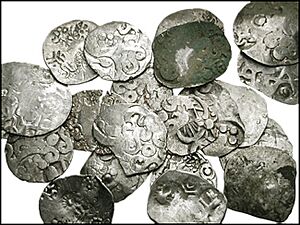
By the 5th century BCE under the reign of King Mahakosala, the neighboring Kingdom of Kashi had been conquered. Mahakosala's daughter was the first wife of King Bimbisara of Magadha. As a dowry, Bimbisara received a Kashi village that had a revenue of 100,000. This marriage temporarily eased tensions between Koshala and Magadha.
By the time of Mahākosala's son Pasenadi, Kosala had become the suzerain of the Kālāma tribal republic, and Pasenadi's realm maintained friendly relations with the powerful Licchavi tribe which lived to the east of his kingdom.
During Pasenadi's reign, a Mallaka named Bandhula who had received education in Takṣaśilā, had offered his services as a general to the Kauśalya king so as to maintain the good relations between the Mallakas and Kosala. Later, Bandhula, along with his wife Mallikā, violated the Abhiseka-Pokkharaṇī sacred tank of the Licchavikas, which resulted in armed hostilities between the Kauśalya and the Licchavikas. Bandhula was later treacherously murdered along with his sons by Pasenadi. In retaliation, some Mallakas helped Pasenadi's son Viḍūḍabha usurp the throne of Kosala to avenge the death of Bandhula, after which Pasenadi fled from Kosala and died in front of the gates of the Māgadhī capital of Rājagaha.
At some point during his reign, Viḍūḍabha fully annexed the Kālāmas. That the Kālāmas did not request a share of the Buddha's relics after his death was possibly because they had lost their independence by then.
Shortly after the Buddha's death, the Viḍūḍabha invaded the Sakya and Koliya republics, seeking to conquer their territories because they had once been part of Kosala. Viḍūḍabha finally triumphed over the Sakyas and Koliyas and annexed their state after a long war with massive loss of lives on both sides. Details of this war were exaggerated by later Buddhist accounts, which claimed that Viḍūḍabha's invasion was in retaliation for having given in marriage to his father the slave girl who became Viḍūḍabha's mother, and that he exterminated the Sakyas. In actuality, Viḍūḍabha's invasion of Sakya might instead have had similar motivations to the Māgadhī king Ajātasattu's conquest of the Vajjika League because he was the son of a Vajjika princess and was therefore interested in the territory of his mother's homeland. The result of the Kauśalya invasion was that the Sakyas and Koliyas were absorbed into Viḍūḍabha's kingdom.
The massive life losses incurred by Kosala during its conquest of Sakya weakened it significantly enough that it was itself was soon annexed by its eastern neighbour, the kingdom of Magadha, and Viḍūḍabha was defeated and killed by the Māgadhī king Ajātasattu.
Under the reign of Mahapadma Nanda of Magadha, Koshala rebelled but the rebellion was put down.
Under Mauryan rule
It is assumed that during the Mauryan reign, Kosala was administratively under the viceroy at Kaushambi. The Sohgaura copper plate inscription, probably issued during the reign of Chandragupta Maurya deals with a famine in Shravasti and the relief measures to be adopted by the officials. The Yuga Purana section of the Garga Samhita mentions about the Yavana (Indo-Greek) invasion and subsequent occupation of Saket during the reign of the last Maurya ruler Brihadratha or Pushyamitra Shunga.
Post-Mauryan period
The names of a number of rulers of Kosala of the post-Maurya period are known from the square copper coins issued by them, mostly found at Ayodhya. The rulers, forming the Deva dynasty, are: Muladeva, Vayudeva, Vishakhadeva, Dhanadeva, Naradatta, Jyesthadatta and Shivadatta. There is no way to know whether king Muladeva of the coins is identifiable with Muladeva, murderer of the Shunga ruler Vasumitra or not (though a historian, Jagannath has tried to do so). King Dhanadeva of the coins is identified with king Dhanadeva (1st century BCE) of Ayodhya inscription. In this Sanskrit inscription, King Kaushikiputra Dhanadeva mentions about setting a ketana (flag-staff) in memory of his father, Phalgudeva. In this inscription he claimed himself as the sixth in descent from Pushyamitra Shunga. Dhanadeva issued both cast and die-struck coins and both the types have a bull on obverse.
Other local rulers whose coins were found in Kosala include: a group of rulers whose name ends in "-mitra" is also known from their coins: Satyamitra, Aryamitra, Vijayamitra and Devamitra, sometimes called the "Late Mitra dynasty of Kosala". Other rulers known from their coins are: Kumudasena, Ajavarman and Sanghamitra.
See also
- Kosala Kingdom
- Ayodhya
- Rama
- Prasenjit of Kosala
- Janapada
- Mahajanapada
- Ancestors of Rama
- List of Ikshvaku dynasty kings


